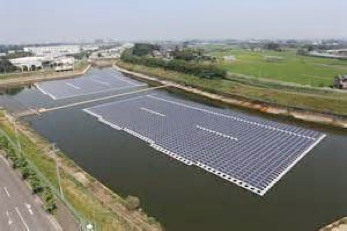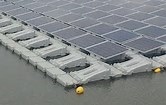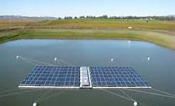SolarOne™ One simple decision...a lifetime of savingssm
Solar Electric Financing • Leasing • Sales • Design • Engineering • Installation • Monitoring

SolarOne™ One simple decision...a lifetime of savingssm
Solar Electric Financing • Leasing • Sales • Design • Engineering • Installation • Monitoring

SolarOne
Financial.llc.
3.5 MW Floating Solar Arrays - where land area is either used for agriculture or in general not available for ground or roof mount due to business use.
Floating Solar Arrays
The panels are lying on the water body and they attract the sun, but they can use the water to cool themselves down.
What happens with land-based solar or rooftop solar is that when it gets very hot, it starts to lose efficiency -- it produces less power -- it’s contrary to what we might think. We would think that when it’s hot it would produce more power, but it’s actually producing less.
So if you can use a water body to cool the panels down, so they don’t lose efficiency, they’re at a constant efficiency level, which is an advantage over land-based. In Australia, this was the first floating solar plant.
How It Can Work
In the future, these systems may be used over water retention areas that are designed to accumulate the excess water generated during wet seasons, or on agricultural areas where the land area is used for growing and cannot be lost to solar ground mount systems. These systems are anchored and will rise and fall with the water level. These systems are not advised for high wind areas.
The system would not be installed on the open ocean or in ecologically-sensitive areas, but instead on reservoirs already in use for industrial or agriculture purposes. Even then, the panels are designed to allow oxygen to permeate through them, so that the water underneath won't become stagnant. In some cases, the panels could even help reduce evaporation and excess algae growth.
Still for the purpose of making the technology efficient and ready to market, the system is designed in such way that on a solar platform it is possible to assemble as many identical modules as needed for the power rating desired. Each module produces a standard amount of 200 kiloWatt electricity, and more power can be achieved by simply adding more modules to the plant.
So how does the Floating Solar Arrays work? Solar PV systems have a major drawback of occupying large land areas. Several countries around the world do not have large free-land areas, and hence could not implement solar PV systems on a large scale. These problems were addressed with the advent of floating solar panel technology. The floating solar panel technology utilizes water surface for the installation of solar panels. These floating solar power plants can be installed upon ponds, lakes, rivers, reservoirs and sea. The floating solar power plant comprises floating system (floating structure and floater). The floating solar panels have several advantages over land-mounted solar panels, such as increased efficiency and evaporation control. Solar panels work more efficiently at low temperature. Floating solar panels have increased efficiency, due to the cooling effect of water.




© 2019 SolarOne Financial, llc. • Terms and Conditions • Privacy Policy